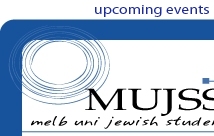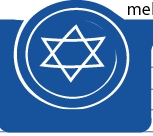 |
MUJAM
> Trip to Poland
An
extract from Ben Pask’s diary from his trip to Poland…
Over the summer holidays I
was privileged enough to have gone to Poland for a few days on the AUJS Poland
Heritage Tour. While I was there I wrote a diary and since Holocaust Awareness
Week is coming up, I thought I would share parts of it with everyone. For all
those who are interested in going on AUJS Achshav at the end of year, I
recommend the Poland trip as an ad-on, because it is not very expensive compared
to what you could be paying for it and I found that it made the experience
easier going with friends.
DAY 1
“We took our bus to the Jewish cemetery. We saw a small wall of gravestones
that were destroyed. We also saw a mass grave surrounded by gravestones with a
stripe two-thirds of the way up to symbolize how their lives were cut short.
Every morning in the Ghetto people would collect dead bodies off the streets and
take them to the cemetery.
“In the cemetery there was a vegetable plot and Jews used to smuggle food from
there into the Ghetto. Some even chose to live in large graves, where the
gravestone hid them from the Nazis. Then at night they would go out to go to the
toilet, get food, etc., so they wouldn’t get caught. We heard a story of one
family who at night heard the German’s footsteps and tried to hurry back into
their grave, but they were caught and killed.
“After we went to the Ghetto wall. The Jews built it for the Germans thinking
that it would benefit them. We saw an Umschlagplatz, which was where the Jews
gathered to get on trains to Treblinka (Jews were told that they were going to
resettle in the East). All I could think about there were little kids standing
there waiting for their death.
“After this we went to Mila 18, the only existing bunker where the Jews hid
during the uprising and later committed suicide, as opposed to capture by the
Germans.”
DAY 2
“Today was tough. This morning we went to Tykocin, a small town which before
the Holocaust housed a Jewish majority. It had originally been apart of Soviet
territory, but then the Germans took it. They had apologized for the Poles for
taking the Jews possessions only a couple of days before. After another few days
though, they took all 2,500 Jews into the forest (men by foot, women and
children by truck) and shot them all. There were 3 mass graves out in the
forest, but it’s just so hard to imagine. In the actual town we visited the
Shul, which is kept in tact although no Jews live there anymore.
“Treblinka was terrible. At the entrance there are train tracks. They would
continue on past the station only so the Jews would think that it continued on
to the East. Except for those who would be chosen to help get people off the
train or sort possessions, the others would have to strip and walk towards their
death, the gas chamber. It is just so hard to comprehend that 800,000+ people
perished there, especially because none of those buildings are there now. The
Germans pulled them down when they left. There were just stones with the names
of towns whose citizens perished there, along with blank ones for those we
don’t know of. There is also a massive monument. I kept trying to picture what
was going on 60 years ago. What I was thinking of was all those lives that
weren’t born because of those who perished, because of those fucking Germans.
I feel now that I have to mourn not only for those who died, but for those who
weren’t born as well…
“I didn’t feel the intensity of Treblinka until we left. On the bus I looked
out the window at the snowy fields and thought, ‘What happened there 60 years
ago? Was someone being shot?’
“In Chavurah I thought about the coldness of Treblinka and only then could I
picture people walking to their death. It was so dark in the camp, which I think
intensified the feeling. I feel so scared at the moment – living in the
Diaspora, of another Shoah. I hate the Diaspora; I want to live in Israel.
“I am scared of going to sleep at the moment – I will have nightmares…”
DAY 3
“This morning our first stop was the old cemetery in Lublin. I don’t find
the cemeteries emotional, probably because we have cemeteries at home. Keren
said that the fact that there was proof of a Jewish community there before is
emotional, because now there are only 4 Jews left in Lublin.
“Our next stop was Majdanek and that was shocking. The monument at the
beginning symbolized how easy it was going down (shallow tamp), but how hard it
was to get back up (steep stairs with a blocked view of the light). As you got
higher, you could see the light, and getting to the top symbolized freedom.
“Inside the camp was terrible. It was just so hard to believe that this was
where people were gassed, where people were murdered. In a room we went in the
Germans had dropped in cans of Zyklon B. There was a little room where one
German would look in through a peephole to see if everyone was dead. People in
our group were crying in there. I wanted to tell them ‘it’s alright’, but
it wasn’t. It definitely wasn’t. There were blue marks on the ceiling from
the gas. We went into a cabin that had some sort of museum in it. There were
uniforms in there and things which were stolen from the Jews. What really upset
me (and always will) were photos of people and underneath an explanation of what
happened. I felt a shudder inside me whenever I saw ‘died at Majdanek’
underneath. We also went into a cabin full of stolen shoes, and 3 which showed
living conditions inside the camp.
“After that we went to the crematorium. It was awful. I wanted to look around
the different rooms inside, but I felt to scared. Outside was a big monument
that was filled with ashes, covered by a dome. It really smelt bad – the ashes
of hundreds of thousands. Majdanek was so terrible, I never want to go back.”
DAY 4
“This morning we went to Auschwitz-Birkenau. It was disgusting. They were
selling posters there – it made me sick. At first we watched a short video in
the theatre. Then we went inside the camp. It didn’t look anything like
Majdanek – someone described its appearance as similar to a college campus.
But then we went inside buildings. There were museums inside the buildings. What
we saw was horrifying; models of gas chambers, examples of living conditions,
photos of people. Down the corridors were photos and names of inmates. I looked
around for any of my family members who were murdered in Auschwitz. There were
other pictures of really skinny people. Underneath it said their name, their
weight before they entered the camp and their weight after being in the camp.
One person came into the camp at 75kg and went out at 25kg. It was horrifying.
There were piles of prisoners’ possessions as well, including hair. In the
pile of suitcases I saw one that was labeled with my great-grandmother’s
maiden name…
“We went down to blocks 10 and 11. Block 10 was where Mengele performed his
experiments and block 11 was the prison inside the prison. In between the two
blocks was what is known as ‘The Death Wall’. This was where they lined up
prisoners and shot them. After these blocks we went to see the gas chambers.
Although they are shocking, Majdanek was so much worse to be at, purely because
of the surroundings.
“After Auschwitz 1 we went on the bus for lunch, then we had a short ride to
Auschwitz 2 (Birkenau). The conditions there were shocking – i.e. communal
bathrooms. It also felt really grotty because it was so muddy. I felt emotional
inside Birkenau because I was thinking, ‘This is where my great-grandmother
got off the train. This is the path she walked to her death.’ The gas chambers
and crematoriums in Birkenau were destroyed. After we saw their remains we said
Tehillim, Kaddish and sang the Hatikvah. One of the strangest feelings I will
ever have is leaving Birkenau, it was truly confusing…”
|
 |
 |















